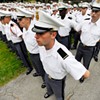Switch to the mobile version of this page.
Vermont's Independent Voice
- News
- Arts+Culture
- Home+Design
- Food
- Cannabis
- Music
- On Screen
- Events
- Jobs
- Obituaries
- Classifieds
- Personals
Browse News
Departments
-
Education

Scott Official Pushes Back on Former State…
-
News

Burlington Budget Deficit Balloons to $13.1 Million
-
Education

Senate Committee Votes 3-2 to Recommend Saunders…
- Court Rejects Roxbury's Request to Block School Budget Vote Education 0
- Norwich University Names New President Education 0
- Media Note: Mitch Wertlieb Named Host of 'Vermont This Week' Health Care 0
Browse Arts + Culture
View All
local resources
Browse Food + Drink
View All
Browse Cannabis
View All
-
Culture

'Cannasations' Podcaster Kris Brown Aims to 'Humanize'…
-
True 802

A Burlington Cannabis Shop Plans to Host…
-
Business

Judge Tosses Burlington Cannabiz Owner's Lawsuit
-
Health + Fitness

Vermont's Cannabis Nurse Hotline Answers Health Questions…
-
Business

Waterbury Couple Buy Rare Vermont Cannabis License
Browse Music
View All
Browse On Screen
Browse Events
Browse Classifieds
Browse Personals
-

If you're looking for "I Spys," dating or LTRs, this is your scene.
View Profiles
Special Reports
Pubs+More
New Proposed Wake Boat Rules Edge Toward a Compromise
Published June 20, 2023 at 6:00 p.m.
Newly released proposed rules for the use of wake boats on Vermont’s lakes and ponds would be the most restrictive in the nation. But some say they don’t go far enough in regulating the large, powerful motorboats.
A state body called the Interagency Committee on Administrative Rules approved the proposed rules on June 12. They would limit the craft to lakes that contain at least 50 contiguous acres where the lake is at least 20 feet deep, and wake boats would need to stay at least 500 feet away from shore when being used for wake surfing. Operators would be required to decontaminate their wake boats before moving them from one lake to another.
A group of Vermont lake users called Responsible Wakes for Vermont Lakes, which set off a discussion about wake boats when it petitioned the Department of Environmental Conservation last year to regulate them, is pushing for a 1,000-foot buffer between boat and shore to prevent shoreline erosion.
Organizer Jack Widness said he's encouraging the group's 900 supporters to turn out at public hearings scheduled for early August.
“We do not agree in terms of the science,” Widness said of the 500-foot buffer. “We’re very disappointed, and we think they can do better.”
 Wake boats are designed to create a wave for surfing. The DEC has held public hearings on regulating the boats and plans to hold another in-person hearing on August 1 in Montpelier, said Oliver Pierson, manager of the DEC’s Lakes and Ponds Management and Protection Program. There will also be a virtual hearing on August 3. Sixty people will be allowed to speak at each, and others can submit written testimony. If people don't get a chance to speak, Pierson said, he expects the DEC to hold another hearing.
Wake boats are designed to create a wave for surfing. The DEC has held public hearings on regulating the boats and plans to hold another in-person hearing on August 1 in Montpelier, said Oliver Pierson, manager of the DEC’s Lakes and Ponds Management and Protection Program. There will also be a virtual hearing on August 3. Sixty people will be allowed to speak at each, and others can submit written testimony. If people don't get a chance to speak, Pierson said, he expects the DEC to hold another hearing.
Pierson said in an interview on Monday that he was aware that many of the people who have testified in previous hearings think a 500-feet buffer isn’t large enough.
“The Agency of Natural Resources decided to stick with that 500-feet limit because it’s supported by science,” he said, noting that his agency is required to resolve conflicts over the use of public waters in the least restrictive manner available. The science he was referring to is a study from a Minneapolis laboratory that shows wake boat waves require 425 to 600 feet to dissipate to the levels created by conventional motorboats.
“We recognize many Vermonters think it should be more restrictive,” Pierson said.
Candy Moot, a Lake Seymour homeowner who has been active in the wake boat debate, said on Friday that the proposal is a good compromise between the needs of wake boat owners and those who worry they will cause shoreline erosion and affect smaller boats.
Opponents have noted that the boats carry water tanks that are used as ballast, raising the risk that when they empty or fill the tanks, they’ll contaminate lakes that don’t now have invasive species. Moot and others who have been active in the issue particularly like the “home lake rule,” which requires wake boat operators to have their boats decontaminated by a registered service provider before they can launch them in a new lake in order to reduce the risk of transferring an aquatic invasive species.
No current rules govern the movement of wake boats from one lake to another, Moot noted — so she sees any change as a positive development. She added that she’d like to see the buffer extended beyond 500 feet, but she accepts that compromise is part of the public process.
“The home rule part is not foolproof, but right now we are 100 percent exposed to any negative effects of wake boats,” Moot said. “This rule gets us to 80 or 90 percent, and that’s pretty darn good.”
Rodney Putnam, a Hinesburg resident who owns a wake boat on Lake Iroquois, said he plans to testify.
"It unfairly singles us out," Putnam said. "There are lots of other boats that are heavy, that put up the same wave action we do, and they're going to be able to go around the lake ... and I can't."
Widness said that while his group will protest the 500-foot buffer, members are very pleased with the other provisions in the proposal, particularly the home lake rule.
“We were ecstatic when that was added to the rulemaking,” he said.
After the public comment period, the rules will head to a legislative rulemaking committee this fall known as LCAR. If they are approved there, Pierson said he expects them to be implemented next spring before boating season starts.
 Thirty-one of Vermont’s 800 lakes and ponds meet the characteristics laid out in the rules, so they would be designated as places open to wake boating if the rules pass.
Thirty-one of Vermont’s 800 lakes and ponds meet the characteristics laid out in the rules, so they would be designated as places open to wake boating if the rules pass.
Susan Gresser owns a home on one of the 31, the remote 400-acre Little Averill Lake in the Northeast Kingdom. She’d like to see wake boats restricted to Vermont’s largest lakes, Lake Champlain and Lake Memphremagog.
“I get nervous in my kayak or canoe when there are big waves,” said Gresser, who is working with others in her area on a petition to exempt Little Averill and its neighbor, the 800-acre Big Averill Lake, if the proposal passes.
East Montpelier kayaker Chip Stone, who paddles on Caspian Lake and the Waterbury Reservoir, plans to submit written testimony against the proposed rules. He doesn't want to see the boats on Vermont's inland lakes and ponds at all.
“There is a place for wake boats, and that place is the open waters of Champlain and Memphremagog,” he said. “I don’t think the inland lakes are capable of accommodating wake boats and traditional uses such as swimming, paddling and so forth.”
One group that's unlikely to provide feedback is the Federation of Vermont Lakes and Ponds, which includes about 45 local lake associations and individuals. Its president, Pat Suozzi of Hinesburg, has been watching the discussion closely, but she said she doesn’t know if her group will testify in the next round of hearings.
“Our position for several years before all this started has been that DEC needs to make the rules,” she said. “We feel they’re in a better position to look at all the scientific data and make a proposal that I think we can all live with.”
A state body called the Interagency Committee on Administrative Rules approved the proposed rules on June 12. They would limit the craft to lakes that contain at least 50 contiguous acres where the lake is at least 20 feet deep, and wake boats would need to stay at least 500 feet away from shore when being used for wake surfing. Operators would be required to decontaminate their wake boats before moving them from one lake to another.
A group of Vermont lake users called Responsible Wakes for Vermont Lakes, which set off a discussion about wake boats when it petitioned the Department of Environmental Conservation last year to regulate them, is pushing for a 1,000-foot buffer between boat and shore to prevent shoreline erosion.
Organizer Jack Widness said he's encouraging the group's 900 supporters to turn out at public hearings scheduled for early August.
“We do not agree in terms of the science,” Widness said of the 500-foot buffer. “We’re very disappointed, and we think they can do better.”
Related Opponents of Wake Boats Seek New Rules, Roiling Lake Communities

Opponents of Wake Boats Seek New Rules, Roiling Lake Communities
By Anne Wallace Allen
Environment
Pierson said in an interview on Monday that he was aware that many of the people who have testified in previous hearings think a 500-feet buffer isn’t large enough.
“The Agency of Natural Resources decided to stick with that 500-feet limit because it’s supported by science,” he said, noting that his agency is required to resolve conflicts over the use of public waters in the least restrictive manner available. The science he was referring to is a study from a Minneapolis laboratory that shows wake boat waves require 425 to 600 feet to dissipate to the levels created by conventional motorboats.
“We recognize many Vermonters think it should be more restrictive,” Pierson said.
Candy Moot, a Lake Seymour homeowner who has been active in the wake boat debate, said on Friday that the proposal is a good compromise between the needs of wake boat owners and those who worry they will cause shoreline erosion and affect smaller boats.
Opponents have noted that the boats carry water tanks that are used as ballast, raising the risk that when they empty or fill the tanks, they’ll contaminate lakes that don’t now have invasive species. Moot and others who have been active in the issue particularly like the “home lake rule,” which requires wake boat operators to have their boats decontaminated by a registered service provider before they can launch them in a new lake in order to reduce the risk of transferring an aquatic invasive species.
No current rules govern the movement of wake boats from one lake to another, Moot noted — so she sees any change as a positive development. She added that she’d like to see the buffer extended beyond 500 feet, but she accepts that compromise is part of the public process.
“The home rule part is not foolproof, but right now we are 100 percent exposed to any negative effects of wake boats,” Moot said. “This rule gets us to 80 or 90 percent, and that’s pretty darn good.”
Rodney Putnam, a Hinesburg resident who owns a wake boat on Lake Iroquois, said he plans to testify.
"It unfairly singles us out," Putnam said. "There are lots of other boats that are heavy, that put up the same wave action we do, and they're going to be able to go around the lake ... and I can't."
Widness said that while his group will protest the 500-foot buffer, members are very pleased with the other provisions in the proposal, particularly the home lake rule.
“We were ecstatic when that was added to the rulemaking,” he said.
After the public comment period, the rules will head to a legislative rulemaking committee this fall known as LCAR. If they are approved there, Pierson said he expects them to be implemented next spring before boating season starts.
Related Wake Boat Opponents Pack Vermont Hearing on Regulation

Wake Boat Opponents Pack Vermont Hearing on Regulation
By Anne Wallace Allen
News
Susan Gresser owns a home on one of the 31, the remote 400-acre Little Averill Lake in the Northeast Kingdom. She’d like to see wake boats restricted to Vermont’s largest lakes, Lake Champlain and Lake Memphremagog.
“I get nervous in my kayak or canoe when there are big waves,” said Gresser, who is working with others in her area on a petition to exempt Little Averill and its neighbor, the 800-acre Big Averill Lake, if the proposal passes.
East Montpelier kayaker Chip Stone, who paddles on Caspian Lake and the Waterbury Reservoir, plans to submit written testimony against the proposed rules. He doesn't want to see the boats on Vermont's inland lakes and ponds at all.
“There is a place for wake boats, and that place is the open waters of Champlain and Memphremagog,” he said. “I don’t think the inland lakes are capable of accommodating wake boats and traditional uses such as swimming, paddling and so forth.”
One group that's unlikely to provide feedback is the Federation of Vermont Lakes and Ponds, which includes about 45 local lake associations and individuals. Its president, Pat Suozzi of Hinesburg, has been watching the discussion closely, but she said she doesn’t know if her group will testify in the next round of hearings.
“Our position for several years before all this started has been that DEC needs to make the rules,” she said. “We feel they’re in a better position to look at all the scientific data and make a proposal that I think we can all live with.”
Disclosure: Anne Wallace Allen's partner owns property on one of the 31 lakes deemed suitable for wake boats in the DEC's draft rule.
Related Stories
Got something to say?
Send a letter to the editor
and we'll publish your feedback in print!
Tags: Environment
More By This Author
About The Author

Anne Wallace Allen
Bio:
Anne Wallace Allen covers breaking news and business stories for Seven Days. She was the editor at the Idaho Business Review and a reporter for VTDigger and the Associated Press in Montpelier.
Anne Wallace Allen covers breaking news and business stories for Seven Days. She was the editor at the Idaho Business Review and a reporter for VTDigger and the Associated Press in Montpelier.
Comments
Comments are closed.
From 2014-2020, Seven Days allowed readers to comment on all stories posted on our website. While we've appreciated the suggestions and insights, right now Seven Days is prioritizing our core mission — producing high-quality, responsible local journalism — over moderating online debates between readers.
To criticize, correct or praise our reporting, please send us a letter to the editor or send us a tip. We’ll check it out and report the results.
Online comments may return when we have better tech tools for managing them. Thanks for reading.
- 1. Scott Official Pushes Back on Former State Board of Ed Chair's Testimony Education
- 2. Burlington Budget Deficit Balloons to $13.1 Million News
- 3. Home Is Where the Target Is: Suburban SoBu Builds a Downtown Neighborhood Real Estate
- 4. A Former MMA Fighter Runs a Wildlife Rehabilitation Center in Cabot News
- 5. Legislature Advances Measures to Improve Vermont’s Response to Animal Cruelty Politics
- 6. Vermont Rep. Emilie Kornheiser Sees Raising Revenue as Part of Her Mission Politics
- 7. Senate Committee Votes 3-2 to Recommend Saunders as Education Secretary Education
- 1. Totally Transfixed: A Rare Eclipse on a Bluebird Day Dazzled Crowds in Northern Vermont 2024 Solar Eclipse
- 2. Zoie Saunders, Gov. Scott’s Pick for Education Secretary, Faces Questions About Her Qualifications Education
- 3. Don't Trash Those Solar Eclipse Glasses! Groups Collect Them to Be Reused 2024 Solar Eclipse
- 4. State Will Build Secure Juvenile Treatment Center in Vergennes News
- 5. Vermont Awarded $62 Million in Federal Solar Incentives News
- 6. Queen of the City: Mulvaney-Stanak Sworn In as Burlington Mayor News
- 7. New Jersey Earthquake Is Felt in Vermont News






































